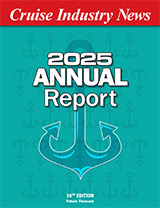According to the latest consumer survey prepared for Cruise Lines International Association (CLIA), Americans are not only increasingly aware of cruise vacations but strongly interested in either a repeat cruise or trying one for the first time. In a U.S. population of 304 million, 73 million Americans have cruised before and 36.1 million, from a core target market (25+ years of age, $40,000+ household income) of 133 million, reported that they are “likely” to take a cruise vacation in the next three years.
Consistent with previous years’ studies, the “2011 Cruise Market Profile Study,” conducted by TNS also found that a significant majority of consumers – 94 percent – rate cruising as a satisfying vacation experience with 45 percent rating a cruise as “extremely satisfying,” making a cruise vacation a satisfaction leader among vacation choices. The study surveyed over 1,300 past cruisers and non-cruisers to determine vacation preferences and attitudes, plans for future vacationing, spending patterns, travel agent usage, and other topics, drawing comparisons among numerous types of vacations, including cruises.
“Based on analysis of responses to the Cruise Market Profile Study, the cruise industry can be optimistic about its continued growth and success,” said Christine Duffy, CLIA’s CEO and President. “CLIA member lines have had an average annual passenger growth rate of more than seven percent since 1980. In 2010, capacity increased by 8.1 percent yet CLIA member line ships continued to operate at 103.1 percent occupancy. The reasons for this success, I think, are reflected in what consumers are telling us about their attitudes toward vacationing and cruising in particular. In a nutshell, the cruise industry continues to innovate and deliver on the cruise product promise, with the result that millions of Americans are intending to take a cruise in the near future.”
Among the highlights of the 2011 Cruise Market Profile:
Cruise Intentions and Attitudes
• Based on responses to the survey, 36 million Americans (25 years+, $40K+ income) have an intention to cruise in the next three years, up from 33 million in the 2008 study and 31 million in 2006.
• Seventy-seven percent of past cruise vacationers expressed interest in a cruise vacation in the next three years and 50 percent of non-cruise vacationers expressed an interest in taking their first cruise within the next three years.
• Cruise vacation satisfaction remains high and is a driver of repeat cruise business. Overall satisfaction rates are 94 percent and, compared to other vacations, cruise vacations are among the leaders in “extreme satisfaction” (45 percent).
• People view all vacation categories as somewhat expensive but most people view cruise vacations as a superior value. Nearly twice as many (17 percent) equate cruising with very high value as land-based vacations (9 percent). Among past cruise vacationers, the gap swells (21 percent vs. 8 percent) as a result of past experience.
• Awareness of the cruise vacation experience is high and growing. Thirty-two percent of the study’s representative sample cites increased awareness of cruise vacations in the past year or two – four times as many who expressed decreased awareness (eight percent).
• Of respondents who provided information about their last cruise, 60 percent have cruised in the past and 40 percent claimed their last cruise was their first cruise, indicating that the cruise industry continues to attract new guests.
• The total study sample (cruisers and non-cruisers) ranked the following as “much better/somewhat better” for cruises compared to all other vacation categories: Chance to visit multiple destinations (56 percent) ; Being pampered (44 percent) ; Fine dining (51 percent) ; Just getting away from it all (44 percent).
• While varying by cruise line and market segment, the top ten list of where consumers plan to take their next cruise vacation includes: 1. Caribbean, 2. Alaska, 3. Bahamas, 4. Hawaii, 5. Bermuda, 6. Mediterranean/Greek Isles, 7. Europe, 8. Panama Canal, 9. Canada/New England, 10. Mexico.
Cruising Profile
• The core target market for cruise vacations (adults 25+, household incomes $40,000+) represents 44 percent of the US population. Overall, almost one in four (24 percent) of the total US population has cruised at some point in their lives and 11 percent in the past three years (up from 20 percent total and 10 percent in the past three years in the 2008 study).
• The general profile of the 2011 cruise vacationer is upscale (with a median household income of $97K), with a median age of 48, and well-educated (76 percent college graduates).
• While cruise customer demographics and preferences vary by cruise line and the segments of cruise travel, cruise vacationers overall typically travel in pairs with 80 percent traveling with a spouse. Thirty-three percent travel with children, 19 percent with friends, and 18 percent with other (non-child) family members.
• Two in five (38 percent) indicate that they have taken a cruise as part of a group or event, with group travel the leader at 18 percent followed by honeymoons (11 percent) and themed events at (10 percent).
• Those expressing an interest (definitely/probably) in taking a cruise in the next three years indicate that the length of desired cruise averages 7.5 days. Forty percent of those intending to take a first cruise indicated a 3-5 day cruise length choice, more than twice the rate of past cruisers (16 percent).
• Over four out of five (82 percent) cruise vacationers typically agree that a cruise vacation provides a good way to sample destinations that they may wish to visit again.
• Key influencers in selecting a cruise vacation include: The destination (35 percent), overall experience (19 percent), the ship (12 percent), the cost (23 percent), and facilities available such as spa, gym, children facilities, etc. (11 percent).
• When asked about most appealing onboard atmospheres on a cruise, past cruisers and non-cruise vacationers (respectively) indicated their preferences as follows: Casually Elegant (67 percent and 52 percent), Casual (63 percent and 66 percent), Country Club (25 percent and 21 percent), Laid-back (44 percent and 75 percent), and Formal (18 percent and 12 percent).
• Cruise vacationers are travelers and as such are much more likely to own a passport (83 percent) than non-cruising vacationers (51 percent).
Travel Agent Usage
• Cruise vacationers typically use the services of a travel agent more than non-cruise vacationers (68 percent versus 45 percent). (This may, in fact, be an understatement because some consumers may not realize that their online bookings are actually through travel agencies with online booking capabilities.)
• Ninety-three percent of cruisers express satisfaction with their travel agent, including nearly 60 percent expressing very/extreme satisfaction.
• Travel agents remain the distribution channel offering the best service, according to respondents.
• Sixty-six percent of consumers say professional designations encourage them to use an agent.
“While cruising receives generally high marks from all consumers, even those who have never cruised before, it is significant that past cruisers consistently have even higher opinions of their cruise vacation experience in terms of benefits, price perceptions, value, and other factors than those who have never cruised before,” Duffy observed. “This explains why cruising has such guest loyalty and high repeat business; once someone has cruised, the value, variety, and enjoyment is obvious and irresistible.”



